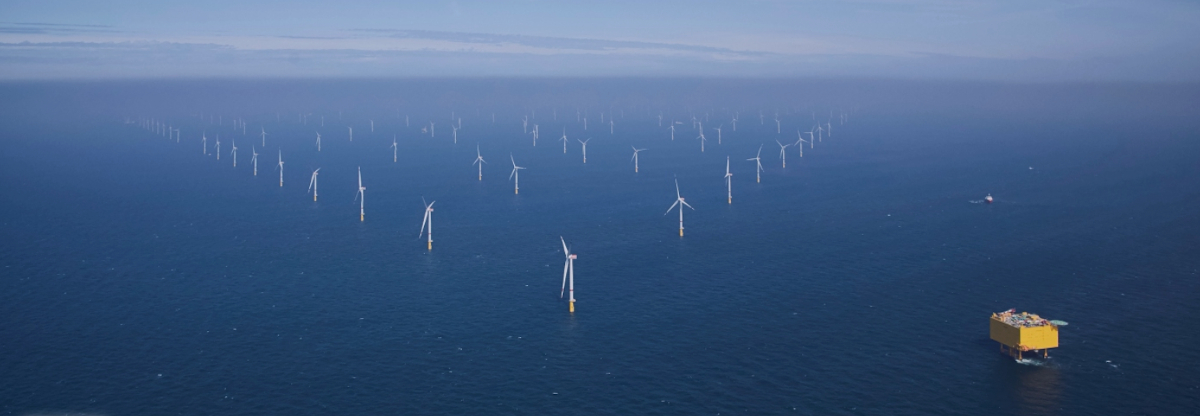Fraport and EnBW Conclude long-term Power Purchase Agreement for non-subsidized He Dreiht Offshore Wind Farm

85 megawatts of green offshore wind energy will improve Fraport’s carbon footprint at Frankfurt Airport
Fraport AG, the publicly listed operator of Frankfurt Airport, and EnBW, the energy provider headquartered in Karlsruhe, have concluded a corporate power purchase agreement (CPPA) for the supply of electricity generated by offshore wind turbines. The long-term contract guarantees Fraport 85 megawatts (MW) from the 900 MW EnBW He Dreiht wind farm in the North Sea off the coast of Germany. The CPPA comes into force in the second half of 2026, and has a term of 15 years.
With the expiry of the previous subsidies under the German Renewable Energy Sources Act (EEG), PPAs are becoming a key element of the energy transition: They provide developers of renewable energy projects with a reliable source of funding while helping purchasers to quickly achieve ambitious climate targets. “Long-term power purchase agreements are a market response to advancing the energy transition even without government support,” explained EnBW CEO Frank Mastiaux. “PPAs equally benefit purchasers, project developers and the climate. For us, they are the key between renewables-generated power and our major customers.”
The CPPA becomes operational in the summer of 2026. It will enable Fraport to transition a substantial portion of electricity consumption at its Frankfurt Airport home base to green energy. Fraport CEO Dr. Stefan Schulte said the agreement marked a key milestone in Fraport’s ongoing decarbonization strategy: “Renewables such as wind and solar are the focus of our climate strategy. They provide the firm foundations for a comprehensive package of measures to systematically reduce our CO2 emissions. Our clearly defined goal is to make Frankfurt Airport carbon-free by 2045. The power sourced from this new offshore wind park will play a central role. As an airport operator, we are especially reliant on a dependable, stable source of power that can be scaled up to meet our growing needs. In EnBW, we have found a strong partner. Compared with the conventional energy sources on which we have previously depended, the new CPPA unlocks potential savings of up to 80,000 tonnes of carbon dioxide per year.”
 85 megawatts of green energy from the North Sea
85 megawatts of green energy from the North Sea
EnBW initiated a new trend in the offshore market with the He Dreiht project in 2017. For the first time in an auction in Germany, the company secured the rights to build the 900 MW wind farm by bidding a subsidy amount of zero cents per kWh. Located about 90 kilometers northwest of the island of Borkum and about 110 kilometers west of Heligoland, He Dreiht is scheduled to go into operation in 2025. The investment decision is planned for 2023. The wind farm with around 60 turbines is currently one of the largest energy transition projects in Europe. It will also be the first to use turbines with a capacity of 15 megawatts each. By way of comparison, Germany’s first offshore wind farm, EnBW Baltic 1 built in 2011, has a capacity of 2.3 megawatts per turbine.
The signing of the CPPA with Fraport also marks the commencement of marketing for further quantities of electricity from He Dreiht. EnBW plans to step up these activities in 2022, enabling further companies to achieve their climate targets using PPAs. The company also plans to use long-term power purchase agreements for the marketing of electricity from two large-scale photovoltaic projects currently under construction, Gottesgabe and Alttrebbin, each of which will generate 150 megawatts. Detailed talks are already underway for Weesow-Willmersdorf, the largest solar farm in Germany.
PPA as a central element of Fraport’s climate strategy
The green electricity supplied from 2026 under the PPA with EnBW to Germany’s largest airport will be harnessed to operate three terminals and many other buildings. The wind-generated power will also be used to illuminate Frankfurt Airport’s apron and four runways, and to charge the growing fleet of more than 500 electric vehicles (EVs) on the airfield, which is some 25 square kilometers in size.
For over a year, Fraport has produced multiple megawatts of eco-friendly electricity itself, via an on-site photovoltaic array. Further arrays are to be built alongside the runways and on existing and new building roofs. The energy mix also includes power from wind parks whose EEG subsidies have expired. The airport consciously leverages electricity from a broad variety of sources to ensure security of supply at all times.
In addition to transitioning to renewables, Fraport’s climate protection strategy foresees improvements to the energy efficiency of existing infrastructure, smart climate control systems, LED technology, and further electrification of the vehicle fleet.
Climate protection has been an integral part of Fraport’s corporate strategy since 1997. For more than 22 years, certification to the EU’s Eco-Management and Audit Scheme (EMAS) has ensured that all material forms of environmental impact attributable to airport operations are continuously monitored. Despite the ongoing crisis in the aviation industry, the company remains committed to its comprehensive environmental protection program. The recently concluded PPA makes a key contribution to these efforts.
